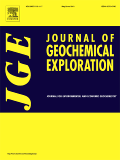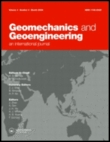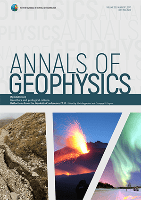
Acta Geodynamica et Geomaterialia
Scope & Guideline
Connecting Earth Sciences with Engineering Excellence
Introduction
Aims and Scopes
- Geophysical Methods and Applications:
The journal emphasizes the use of advanced geophysical techniques, such as gravimetry, seismic analysis, and remote sensing, to explore subsurface structures and processes. These methods are critical for understanding geological formations, natural resources, and environmental assessments. - Geotechnical Engineering and Soil Mechanics:
Research on the behavior of soils and geotechnical materials under various conditions is a key focus. This includes studies on soil stabilization, liquefaction potential, and the mechanical properties of soils, which are essential for civil engineering applications. - Geological and Geochemical Investigations:
Papers often include detailed geological mapping and geochemical analyses to understand mineral deposits, sedimentary environments, and tectonic activity. These studies are vital for resource exploration and environmental geology. - Environmental Geoscience:
The journal also covers topics related to environmental impacts of geological processes, including studies on groundwater evaluation, land degradation, and the effects of climate change on geosystems. - Innovative Modeling Techniques:
There is a strong emphasis on the development and application of innovative modeling techniques, such as empirical mode decomposition and machine learning, to analyze geoscientific data and improve predictive capabilities.
Trending and Emerging
- Data-Driven Approaches in Geosciences:
There is a growing focus on utilizing data-driven methodologies, including machine learning and statistical modeling, to analyze geoscientific data. This trend is significant for improving the accuracy of predictions and interpretations in various geoscience fields. - Climate Impact Studies:
Research addressing the impacts of climate change on geological processes and resources is on the rise. This includes studies on water resource management and the effects of climate variability on geological stability. - Integrated Geophysical and Geological Analyses:
Papers that integrate multiple geophysical methods with geological data for comprehensive analyses are increasingly common. This trend indicates a move towards multidisciplinary approaches in understanding complex geological systems. - Innovations in Soil and Material Engineering:
Recent publications highlight innovative methods for soil improvement and material performance, reflecting a growing interest in sustainable engineering practices. - Monitoring and Assessment of Natural Hazards:
There is an increasing emphasis on the monitoring and assessment of natural hazards, such as landslides and subsidence, using contemporary techniques like InSAR and GNSS, which is crucial for disaster risk reduction.
Declining or Waning
- Historical Geological Studies:
There has been a noticeable decline in papers focusing solely on historical geological events or ancient geological formations. This may be due to a shift towards more contemporary applications and real-time geoscientific monitoring. - Traditional Geodesy:
The traditional approaches to geodesy, such as basic surveying methods, seem to be waning as the journal increasingly emphasizes advanced techniques involving GNSS and remote sensing technologies. - Non-Quantitative Environmental Studies:
Research that lacks quantitative analysis or robust modeling frameworks is becoming less common, indicating a trend towards more data-driven and quantitative approaches in addressing environmental issues.
Similar Journals

JOURNAL OF GEOCHEMICAL EXPLORATION
Charting New Territories in Geochemistry and PetrologyJOURNAL OF GEOCHEMICAL EXPLORATION, published by Elsevier, is a leading journal in the fields of Geochemistry and Economic Geology, with a notable Impact Factor and a commendable performance demonstrated by its Scopus ranking, where it holds the 22nd position out of 154 in Geochemistry and Petrology and 11th out of 43 in Economic Geology. Founded in 1972 and set to converged through 2024, the journal serves as a vital platform for disseminating high-quality research, providing insights into the complex relationships between geological processes and geochemical phenomena. Its articles contribute significantly to the understanding of natural resource exploration and environmental geochemistry, making it an essential resource for researchers, industry professionals, and students alike. Although not an open-access journal, it offers a wealth of knowledge aimed at advancing the field's boundaries and fostering innovative research initiatives. As an established outlet for the latest findings and methodologies, the journal's contributions ensure it remains at the forefront of geochemical exploration.

Geomechanics and Geoengineering-An International Journal
Advancing the Frontiers of Geotechnical InnovationGeomechanics and Geoengineering-An International Journal, published by Taylor & Francis Ltd, serves as a prominent platform for the dissemination of innovative research and advancements in the fields of Geotechnical Engineering and Engineering Geology. With an ISSN of 1748-6025 and E-ISSN of 1748-6033, this journal has established itself as a critical resource within its category, ranking in the Q2 quartile according to the 2023 metrics and positioning itself in the top 38% of the Scopus rankings for Earth and Planetary Sciences. Geomechanics and Geoengineering encompasses a diverse range of topics, including but not limited to soil mechanics, foundation engineering, rock mechanics, and environmental geotechnics, ultimately aiming to advance both theoretical and practical knowledge in these vital areas. This journal not only highlights pioneering research but also facilitates a platform for academia and industry practitioners to collaborate and exchange ideas. While it does not offer open access, it remains a valuable resource for institutions and individuals committed to enhancing their expertise in the geotechnical domain. With convergence years spanning from 2006 to 2024, this journal is equipped to significantly contribute to the evolving landscape of geomechanical research.

Russian Journal of Pacific Geology
Illuminating the Pacific's Geological WondersThe Russian Journal of Pacific Geology is a pivotal resource in the realm of Earth sciences, published by PLEIADES PUBLISHING INC. With an ISSN of 1819-7140 and an E-ISSN of 1819-7159, this journal has established itself as a significant publication for researchers, professionals, and students who explore the intricate geology of the Pacific region. Covering a wide array of topics including Geochemistry, Petrology, Geology, Geophysics, Oceanography, Paleontology, and Stratigraphy, the journal's relevance is underscored by its categorization within Q3 quartile rankings across multiple disciplines in the 2023 metrics. Operating from the United States, its influential publications span from 2007 to 2024, attracting a diverse audience dedicated to advancing the geological sciences. Although not an open access journal, it serves as a valuable repository of knowledge, presenting original research, reviews, and critical discussions that enhance scholarly discourse. The journal is recognized within the global scientific community, addressing significant geological challenges while fostering collaboration and innovation among scholars in the Earth and Planetary Sciences.

GEOSCIENCES JOURNAL
Connecting Researchers to Tackle Environmental Challenges.Welcome to the GEOSCIENCES JOURNAL, a pivotal publication in the fields of Earth and Planetary Sciences and Environmental Science, proudly presented by the Geological Society of Korea. Established in 1997, this journal has become a prominent platform for researchers, professionals, and students, offering a rich collection of peer-reviewed articles that explore a diverse array of geoscientific topics. With an impressive Q2 ranking in both Earth and Planetary Sciences and Environmental Science categories for 2023, it stands as an essential resource in the academic community. Though it operates under a traditional subscription model, GEOSCIENCES JOURNAL remains dedicated to advancing knowledge through rigorous research. Addressed from its headquarters in Seoul, South Korea, the journal aims to foster a deeper understanding of geosciences, encouraging innovation and collaboration in tackling today’s environmental challenges.

Journal of Asian Earth Sciences-X
Bridging Regional Insights with Global PerspectivesJournal of Asian Earth Sciences-X, a distinguished publication by ELSEVIER, is at the forefront of Earth and planetary sciences, particularly focusing on the dynamic fields of geology and earth-surface processes. As an Open Access journal since 2019, it provides unparalleled access to high-quality research, fostering global collaboration and dissemination of knowledge. With an impressive impact factor and ranking in the Q2 category for both Earth-Surface Processes and Geology, it serves as a crucial platform for researchers, professionals, and students alike to share their findings and insights. Situated in the United Kingdom, the journal thrives on contributions that enhance our understanding of Asian geosciences within a broader global context, aiming to tackle major challenges such as climate change and natural resource management. By bridging regional studies with global perspectives, the Journal of Asian Earth Sciences-X is not only a vital resource for academia but also supports sustainable development initiatives across the region.

Journal of Geosciences
Advancing Earth Sciences through Innovative ResearchJournal of Geosciences is a distinguished peer-reviewed journal published by CESKA GEOLOGICKA SPOLECNOST, based in the Czech Republic, that serves as a vital platform for the dissemination of innovative research in the field of Earth and Planetary Sciences. With an ISSN of 1802-6222 and E-ISSN of 1803-1943, this journal has established its significance within the academic community, evidenced by its Q3 ranking in both Earth and Planetary Sciences and Geology. The journal covers a broad array of topics, making it an essential resource for researchers, professionals, and students interested in geoscientific advancements and discoveries. The Journal of Geosciences reflects a commitment to high-quality scholarship, embracing a variety of methodologies and interdisciplinary approaches, and provides open access to its content, thereby encouraging global collaboration and knowledge sharing among geoscientists. With a publication history converging from 2007 to 2024, it continues to be a prominent venue for critical conversations and developments in the ever-evolving field of geosciences.

Geophysics and Geophysical Exploration
Fostering Insights and Innovations in Geophysical ScienceGeophysics and Geophysical Exploration is a prestigious journal dedicated to advancing the fields of geophysics and geophysical exploration. Published by the Korean Society of Earth & Exploration Geophysicists, this journal serves as a vital platform for researchers, professionals, and students to share innovative findings and developments in geophysical methods and technologies. The journal covers a broad range of topics including but not limited to seismic analysis, subsurface modeling, and remote sensing techniques, aimed at addressing the complex challenges in Earth science exploration. Although it does not currently offer open access options, the journal maintains rigorous peer-review standards, ensuring high-quality and impactful research contributions. With its commitment to fostering knowledge exchange in the geophysical community, Geophysics and Geophysical Exploration plays a critical role in enhancing our understanding of the Earth, making it an essential resource for those interested in geoscience and related fields.

Visnyk of Taras Shevchenko National University of Kyiv-Geology
Bridging Local Insights with Global Geological DiscourseVisnyk of Taras Shevchenko National University of Kyiv-Geology is a premier academic journal dedicated to advancing the field of geology and related earth sciences. Published by the esteemed NATL TARAS SHEVCHENKO UNIV KYIV, this journal serves as a vital platform for researchers, professionals, and students to disseminate original research findings, innovative methodologies, and comprehensive reviews that address contemporary geological challenges. With an ISSN of 1728-2713 and an E-ISSN of 2079-9063, the journal is committed to upholding rigorous academic standards and excellence, although it currently operates without an open access model. The Visnyk primarily focuses on topics such as mineralogy, geophysics, geological engineering, and environmental geology, thus providing a broad spectrum of insights into the ever-evolving discipline of geology. Situated in Kyiv, Ukraine, it not only fosters local research but also contributes to the global geological discourse, making it an indispensable resource for anyone engaged in earth sciences.

ANNALS OF GEOPHYSICS
Pioneering Insights into Earth and Planetary SciencesANNALS OF GEOPHYSICS is a prestigious open access journal dedicated to the advancement and dissemination of research in the field of geophysics. Published by the IST NAZIONALE DI GEOFISICA E VULCANOLOGIA in Italy, this journal has embraced open access since its inception in 1948, promoting wide accessibility to cutting-edge research. With an impressive Scopus ranking, placing it in the 52nd percentile within Earth and Planetary Sciences for the category of Geophysics, the journal serves as a vital platform for scholars, researchers, and practitioners seeking to explore the intricate phenomena of our planet. Covering a diverse range of topics in the geophysical community, the ANNALS OF GEOPHYSICS invites contributions that push the boundaries of our knowledge and understanding of geophysical processes, aiding in the development of innovative solutions to urgent environmental challenges. Published continuously from 2002 to 2024, the journal’s commitment to quality and rigor is reflected in its Q3 quartile ranking for 2023, making it a notable resource for the academic community.

INTERNATIONAL GEOLOGY REVIEW
Elevating the discourse in Earth and planetary sciences.INTERNATIONAL GEOLOGY REVIEW, published by Taylor & Francis Inc, is a premier journal dedicated to advancing the field of geology since its inception in 1959. With its Q1 ranking in the field of Geology for 2023, this journal is a significant platform for researchers, professionals, and students exploring the intricacies of Earth and planetary sciences. The journal has been rated in the 81st percentile within Scopus rankings, reflecting its influence and the high quality of articles published. Although it does not offer Open Access options, the journal maintains a rigorous peer-review process to ensure the publication of original and impactful research. With an extensive archive projected to continue until 2024, INTERNATIONAL GEOLOGY REVIEW serves as an essential resource for those seeking to deepen their understanding of geological phenomena, making it a vital contributor to the global scientific community.